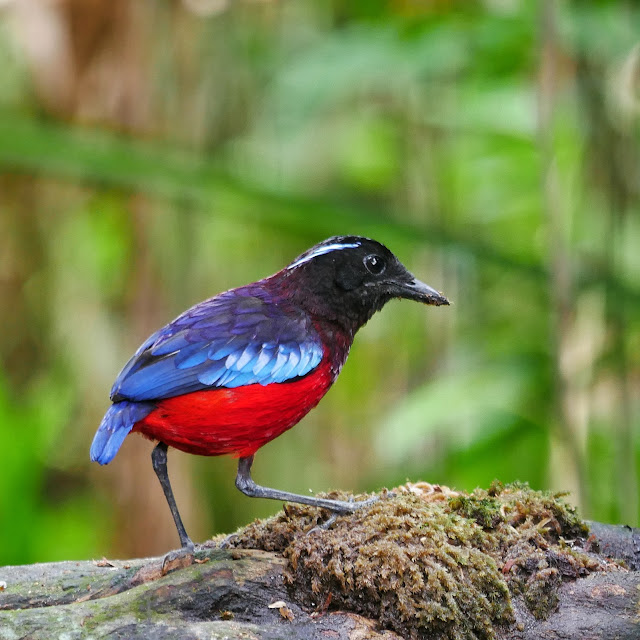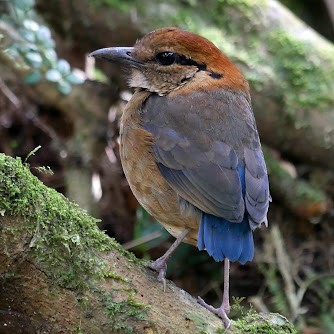Content
Family Birding - 26 Dec 2020
Peregrine Falcon in North America migrate to Peru
More about Coffee and Birds
Took a short time going through some articles on birds and coffee farm. Now I realized there are really a lot of effort on this sustainable farming practice. I would like to share the following links with you. Enjoy the articles.
Coffee Made in the Shade Can Be More Profitable, Thanks to BirdsOctober 1, 2019
https://www.allaboutbirds.org/news/coffee-made-in-the-shade-can-be-more-profitable-thanks-to-birds/
Heroes: Sir David Attenborough
Over the years, we have seen so many naturalists making lots of wildlife documentaries. Everyone has their own unique personality / character. But whenever I think about a naturalist on TV, it would always be him, the one and only David Attenborough. I tried to watch almost every documentaries I can find featuring him. One of the most unforgettable and my favorite series is The Life of Birds. As a birder, I of course bought a copy of the DVD for my own collection.
David Attenborough joined BBC in 1952 and made remarkable journeys into the wilderness to film the wonders of nature. Such an incredibly strong passion for nature, even age could not stop him from sharing his knowledge to the world. I truly believe he has witnessed so many things in life more than anyone else and he have seen the changes to the natural world - good and bad.
He has been to Borneo and he even helped to highlight on the bridge project over Kinabatangan River which was eventually abandoned. Read the article here: https://www.theguardian.com/environment/2017/apr/21/attenborough-guardian-headline-halts-borneo-bridge
Learn about this fascinating figure. Check him out on Google and YouTube. Watch his documentaries.
Here are some links for a start:
https://en.wikipedia.org/wiki/The_Life_of_Birds#DVD_and_book
https://borneoproject.org/tag/david-attenborough/
https://www.bbc.co.uk/teach/nine-astonishing-ways-david-attenborough-shaped-your-world/z4k2kmn
Review: Fraser's Hill
My first visit to Fraser’s Hill dates back to the 1990s, when I was completing my university field practical hours. I chose WWF Fraser’s Hill as my placement site and spent a total of four weeks there. At the time, I had no idea how cold it could get up in the highlands—everything felt chilly, at least by ordinary Malaysian standards. But looking back, I’m truly glad I had the chance to experience what life was like there during those days. Back then, birds were practically everywhere, and most were remarkably approachable. A simple walk along the forest trails would bring you face to face with species like the Large Niltava or the Chestnut-capped Laughingthrush, often perched close to the path. Silver-eared Mesias were abundant, their bright plumage adding color to the misty surroundings.
raser’s Hill was named after a Scotsman, Louis James Fraser. The old story many of us heard was that he went missing in the forest, never to be found. However, according to more recent accounts, Fraser actually returned to Europe, where he tragically met with an accident and died. If you’re interested in learning more about him, you can read further on his Wikipedia page.
According to Pahang Tourism, the hill station sits at 1,524 meters above sea level, although I believe this refers to the highest accessible point by foot. Generally, the main areas of Fraser’s Hill are around 1,200 meters in elevation. Temperatures usually hover between 19°C and 22°C, offering a refreshing escape from the lowland heat.
Fraser’s Hill is regarded as one of the prime birding destinations in Peninsular Malaysia. For decades, it has attracted birdwatchers from around the world. Around 250 bird species have been recorded here, though in a typical visit you might expect to see about 100, depending on the season and how much time you spend exploring. During the migration period, some species pass through while others stay on as wintering visitors.
If you’re planning a birding trip, I usually recommend spending at least three days and two nights at Fraser’s Hill. The journey from Kuala Lumpur city center is often listed as 1.5 hours on some websites and Google Maps, but in reality, it usually takes longer. The uphill road is winding and narrow, and the stretch between Kuala Lumpur and Kuala Kubu Bharu can be busy, especially during weekends and public holidays.
Once you arrive, you’ll find the effort well worth it. Some of the species you might encounter include the Chestnut-capped Laughingthrush, Malayan Laughingthrush, Black Laughingthrush, Silver-eared Mesia, Long-tailed Sibia, Black-throated Sunbird, Streaked Spiderhunter, Large Niltava, Rufous-browed Flycatcher, Little Pied Flycatcher, Red-headed Trogon, Collared Owlet, Orange-bellied Leafbird, Large Cuckooshrike, Black-and-Crimson Oriole, Long-tailed Broadbill, Silver-breasted Broadbill, White-tailed Robin, Streaked Wren-babbler, Pygmy Cupwing (formerly known as Pygmy Wren-babbler), Black-browed Barbet, Fire-tufted Barbet, Golden Babbler, Grey-throated Babbler, Buff-breasted Babbler, Malaysian Partridge, and many more.
Fraser’s Hill remains a timeless sanctuary for both birds and birdwatchers alike—serene, cool, and endlessly rewarding for anyone who loves the natural world.
Watch the video above, which I’ve compiled to showcase some of the amazing bird species found in this beautiful hill station. Besides birds, you might also encounter a few primates, wild boars, and plenty of squirrels—including the adorable Himalayan Striped Squirrel, one of the cutest residents of Fraser’s Hill.
When it comes to food, there are plenty of restaurants around town. Most serve local Malaysian dishes—Chinese, Malay, and Indian—while a few offer Western-style meals.
I hope this gives you a better idea of what to expect from your birding adventure at Fraser’s Hill—a cool, serene destination filled with wildlife and character.
If you’re interested in hiring me as your birding guide at Fraser’s Hill, feel free to reach out via email at nature2pixel@gmail.com or send me a WhatsApp message at +6018-363-2738. I’d be happy to help you make the most of your trip!
Do You Like Coffee?
An email received yesterday "How will the ☕ you drink help birds? Find out now"
Nature Photography with Roger back in 2009
I remember this trip very well. It was my first trip with Roger for 5 days. We covered Kuala Selangor, Fraser's Hill and Hulu Langat. His enthusiasm and passion for butterflies is amazing! I was impressed and soon, I started shooting and looking out for butterflies too. I did another trip with Roger in 2011 and will compile the photos soon.
Throughout the 5 days, we see more things - apart from birds and butterflies, we had sightings of water monitor, tarantula, trapdoor spider, colugo (YOU SHOULD LOOK AT HIS FACE! HE WAS SO AMAZED), and many primates.
Let's take a look at the video. I hope you enjoy this. There are more videos from my YouTube channel which showcases Birds in Malaysia, my Birding in Malaysia trips, and others. Subscribe to the channel and you will be notify when there is a new video uploaded to my channel. Thank you.
It's about Butterflies of Peninsular Malaysia.
Birding in Malaysia - 1 Oct 2020
Family Birding - 4 Oct 2020
Travel Light and Lighter
Birding Day - 24 Sep 2020
Finding Common Kingfisher - 22 Sep 2020
Trip Cancelled due to Bad Weather
Bought 4 Binoculars
Birding in Fraser's Hill - 6th Sept 2020
Birder with Targets - 4th Sept 2020
Forest Birding near KL - 9th Sept 2020
Birder need lifers - 7th & 10th Sept 2020
Sabah Trip 19-24 Aug 2020
Introduction to Birdwatching in Fraser's Hill - 30th Aug 2020
"If any keen birders out there looking for a great weekend escape in nature, be sure to check out Weng Chun birding guide. Just had an amazing day out birding in Fraser’s Hill with no less than 26 new species spotted. Ideal for families, small groups or individuals."
- Rex, South Africa / KL
Guided a family for a morning birdwatching session in Fraser's Hill recently. We started the morning from the carpark and walked along the usual road towards the spot for Red-headed Trogon. Along the way, we passed by a Bottle Brush tree which is a favorite for Long-tailed Sibia, Blue-winged Minla, Black-throated Sunbird and Streaked Spiderhunter. Further up the road, we found Mountain Fulvetta and White-throated Fantail. As we got closer to our destination, I saw several photographers grouping infront of the trail head. Without doubt, they must have spotted the Red-headed Trogon and then we saw a red spot near the photographer. Definitely a Trogon! Everyone enjoyed the view through the binocular. It was a male bird. Not too long after, a female bird showed up. WOW!
I heard the Greater Yellownape (woodpecker) nearby but couldn't locate it as everyone were too occupied with the Trogon.
After a few hours of walking, we took a short break. The 2nd part of the session, we had better luck with some colorful birds and there seems to be more activities going on the late morning. This include Black-eared Shrike-babbler, Silver-eared Mesia, Mountain Tailorbird, Chestnut-capped Laughingthrush, and others.
We ended the morning birdwatching with a family of 5 Malaysian Partridge (which we heard early morning but couldn't find). So, this is a great bird to finish off a great morning!
The birds that we saw during the morning session include (but not limited to)
1. Oriental Magpie Robin
2. Long-tailed Sibia
3. Streaked Spiderhunter
4. Blue-winged Minla
5. Chestnut-capped Laughingthrush
6. Red-headed Trogon
7. Streaked Wren-babbler
8. Rufous-browed Flycatcher
9. Large Niltava
10. Black-throated Sunbird
11. Pacific Swallow
12. Little Cuckoo Dove
13. Buff-breasted Babbler
14. Fire-tufted Barbet
15. Mountain Fulvetta
16. Black-eared Shrike-babbler
17. Silver-eared Mesia
18. Fire-breasted Flowerpecker
19. Mountain Tailorbird
20. Lesser Shortwing
21. White-rumped Munia
22. Lesser Racket-tailed Drongo
23. Mountain Bulbul
24. Grey-chinned Minivet
25. Pygmy Cupwing (previously known as Pygmy Wren-babbler)
26. White-throated Fantail
27. Malaysian Partridge
Mammals List:
1. Dusky Leaf Monkey / Spectacled Leaf Monkey
2. Western Striped Squirrel / Himalayan Striped Squirrel
3. Grey-bellied Squirrel
4. Mountain Red-bellied Squirrel / Pallas's Squirrel














































































